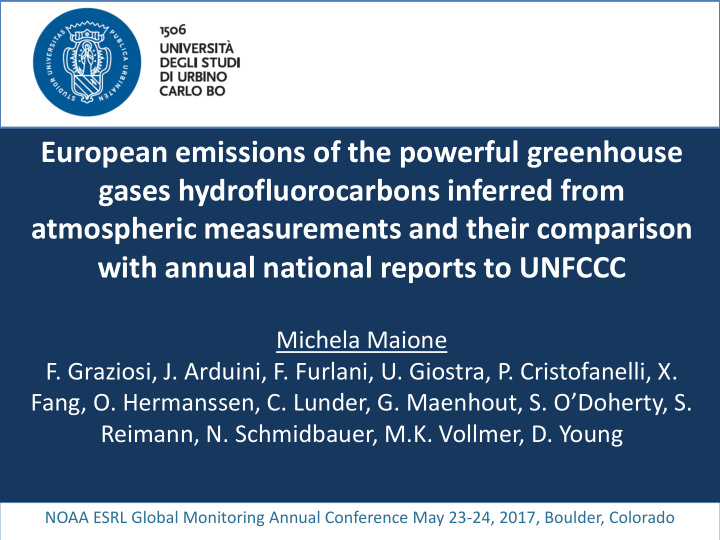



European emissions of the powerful greenhouse gases hydrofluorocarbons inferred from atmospheric measurements and their comparison with annual national reports to UNFCCC Michela Maione F. Graziosi, J. Arduini, F. Furlani, U. Giostra, P. Cristofanelli, X. Fang, O. Hermanssen, C. Lunder, G. Maenhout, S. O’Doherty, S. Reimann, N. Schmidbauer, M.K. Vollmer, D. Young NOAA ESRL Global Monitoring Annual Conference May 23-24, 2017, Boulder, Colorado
HFCs and inverse modelling • Annex I Parties to the UNFCCC submit annual national GHG inventories, whose reliability is crucial in assessing the Parties compliance with the Kyoto Protocol; • UNFCCC requires only bottom-up reporting ; • The top-down approach can be used at the global to the country scale in support of the QA of inventories; • Since emissions control legislation is based on national figures it is important to assess the annual reports at the same geographic scale. Introduction 1/1 method results
High-frequency observations The high-frequency observations of 9 HFCs are combined with an atmospheric particle dispersion model and a Bayesian inversion procedure. Introduction method 1/3 results
Bayesian inversion • To simulate transport to the receptors we calculated the SRR (Source Receptor Relationship) obtained with FLEXPART 20 d backward calculations; • ECMWF data 1° x 1° resolution; • 40.000 particles released every 3 h. The FLEXPART output is incorporated in the inversion algorithm based on the • analytical inversion method by Stohl et al. (2009); Multiplying the SRR with an emission flux taken by an appropriate a priori • emission field gives the simulated mixing ratio at the receptors to be compared with the measurements; We used as a priori the UNFCCC inventory that gives the best correlation • coefficient between the simulated times series and the observations Emissions are then grouped in cells 0.5° x 0.5° lat long. We give emissions • intensity and distribution from 12 countries (or group of countries) in Europe Introduction method 2/3 results
SENSITIVITY TESTS & UNCERTAINTY The overall uncertainty has been calculated as the % difference ( P d) between our reference emission and the standard deviation of a set of a posteriori emission values derived from the following tests: STATION GEOMETRY – (removal of one station or station pair) A PRIORI EMISSION FIELD – MODULATION ( x 0.5; x 1.0; x 2.0) USE OF DIFFERENT A PRIORI – (UNFCC and EDGAR) Introduction method 3/3 results
Top-down emissions of 9 HFCs ( ); UNFCCC country reports ( ); EDGAR ( ) • 2008-2014 average aggregated emissions 84.2±28 Tg-CO 2 -eq·yr –1 (UNFCCC and EDGAR 11 and 35% higher) • Trend: the inversion results do not show any trend in emissions, UNFCCC and EDGAR emissions are increasing by 4.0 and 7.3% yr -1 Introduction method results 1/4
Emissions from twelve European macro-areas • 4 main emitting areas (FR, UK, ES-PT, IT) responsible for the 62% of aggregated emissions • When converted in CO 2 -eq, the aggregated emissions from 12 macro areas are in agreement with UNFCCC for most of the macro areas • Discrepancies are observed when comparing to EDGAR with DE, BE-NE-LU and SEE inventory exceeding the inversion results. Introduction method results 2/4
The case of HFC-134a • Overestimated in the inventories (after 2006) • European MAC directive 2006/40/EC: rejection of vehicles fitted with MACs with high GWP gases or high leak rates • Car manufacturers not ready to substitute HFC-134a with lower GWP fluids compliance with the MAC directive pursued through the reduction of leaking, not followed by a consistent adjustment of EFs. • EFs used by the Italian Environmental Agency have been regularly updated after confrontation with the manufacturers association Introduction method results 3/4
Per-capita emissions in kg-CO 2 -eq·y –1 ·inhabitants -1 • EGD average emission are 183 kg-CO 2 -eq·yr –1 ·inhabitants -1 • Emissions above the European average have been estimated for IE, FR, ES-PT and IT • EGD average is up to 4 times larger than the average top- down global ones (Rigby et al. 2014) and higher than Chinese per-capita (Fang et al. 2015), but lower than those estimated from the West USA (Lunt et al. 2015) Introduction method results 4/4
CONCLUSIONS 1 Despite some discrepancies when considering the specific compounds at the country level, an overall agreement is found when comparing aggregated data; However, this agreement seems to be more due to a cancellation of errors rather than to the accuracy in compiling the emission inventories (see also Lunt et al., 2015); Studies like this could help in identifying which compounds and countries would need more robust emission estimates.
CONCLUSIONS 2 In line with Lunt et al. (2015) the gap at the global level between reported emissions (Annex I countries) and top-down emissions should be essentially due to emissions from non-reporting countries (non-Annex I). Even if the accuracy of the inversion could be improved enlarging the observation network to better constrain low sensitivity regions, results are robust enough to provide interesting insights on the quantification and localisation of emissions and improve estimates at the global scale.
Recommend
More recommend